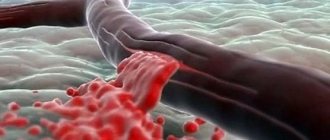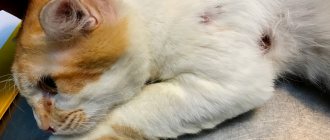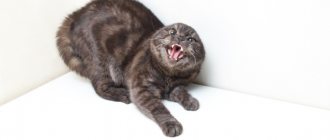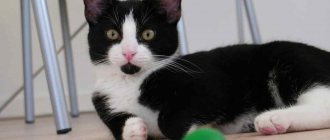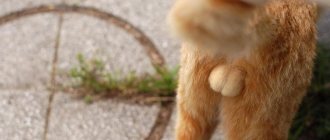Sterilizing a cat sometimes results in blood loss. Internal bleeding in cats is a dangerous condition that develops when the walls of blood vessels are damaged and gastrointestinal diseases occur. Minor blood loss is not dangerous for the animal. However, with significant blood loss, disruption of the functioning of the digestive tract and oxygen starvation of tissues occurs, which can lead to serious consequences for the body.
Diagnostics
The main ways to diagnose internal bleeding in cats include:
- taking anamnesis;
- visual inspection;
- radiography;
- laparocentesis;
- blood tests;
- general urine analysis;
- vaginal smear;
- Ultrasound of the abdominal cavity;
- CT;
- MRI.
Timely diagnosis is carried out to identify signs of internal bleeding in a cat and organize comprehensive treatment.
Main symptoms of internal bleeding in cats
Even if your cat is constantly indoors, injuries or illnesses that cause life-threatening internal bleeding can happen in the house - they didn’t calculate the force of the jump, didn’t make it through the closing door, or tipped over together with the reclining chair; curiosity pushes them to swallow toxins and poisons.
All this is accompanied by damage to blood vessels, which are a fragile transport organ for blood circulation in the body.
Large uncontrolled bleeding is life-threatening and is one of the leading causes of death worldwide, but detecting it inside is very difficult.
Did you know that losing just 2 teaspoons of blood per 1 pound of body weight can lead to hypovolemic shock?
Free consultation Moscow
+7(495)162-70-70
Treatment
How to stop internal bleeding in a cat? In this case, various treatment methods are used, which depend on the severity of the animal’s condition. It is necessary to contact a veterinarian to draw up a treatment regimen, but independent attempts to help can cause the death of the animal.
The main methods of treatment for hemorrhage include:
- pain relief - to improve the pet’s condition;
- intravenous infusion - to stabilize blood pressure;
- blood transfusion - for anemia;
- compression bandages - slowing down blood loss;
- vitamin K - for poisoning and coagulopathies;
- emergency surgery.
Often internal bleeding after sterilization of a cat causes severe complications, including death. Therefore, when the first symptoms of the process appear, it is necessary to urgently contact professionals. To prevent hemorrhage, you should properly care for a sterilized animal.
The cat is bleeding - causes and first aid
The appearance of blood in a cat always frightens owners, especially for pets living in an apartment, when, in general, there are no external reasons for bleeding. It must be remembered that blood in a cat occurs with minor damage to the skin and mucous membranes, for example, with abrasions, but it can be a sign of a general illness or deep lesions of the skin. This article will help you understand at home how dangerous bleeding is in your pet.
The circulatory system in cats, like in other mammals, is of a closed type. In simple terms, blood flows in a circle, more precisely through vessels (hollow tubes) that form two circles of blood circulation. The movement of blood is ensured by the heart (muscle pump, contraction of the walls of blood vessels, valves of the veins), while the blood always moves in one direction, arterial blood (rich in oxygen and nutrients) - from the heart to the organs and tissues; venous (with carbon dioxide and metabolic products) - from organs and tissues to the heart. The question arises: how then does the body nourish itself if the circulatory system is closed?
In tissues and organs, vessels branch into tiny capillaries with the thinnest walls; the walls of all vessels have pores; as a result of this structure of the vascular system, gas exchange and transport of substances occur. The blood itself is a liquid medium, consisting of blood cells and plasma, and due to a number of mechanisms in healthy animals, the blood in the vessels does not clot.
Any damage to the walls of blood vessels of a traumatic or inflammatory nature, as well as blood diseases, lead to bleeding in the animal. Depending on the type of damaged vessel, arterial (from arteries) and venous (from venous vessels) bleeding are distinguished.
Arterial bleeding is the most dangerous, since it is almost impossible to stop the bleeding on your own; surgical intervention is often required. Scarlet blood appears from the arterial vessels, which pulsates, especially strongly from large arteries; arterial bleeding can continue for a long time.
With venous bleeding, dark, cherry-colored blood appears, there is no pulsation, and if small vessels are damaged, it can stop on its own. If there is severe venous bleeding from large vessels, the cat should be shown to a doctor.
Bleeding from the capillaries is usually minor, not life-threatening for the cat, and stops quickly.
Causes of hemorrhages
Internal bleeding may occur for the following reasons:
- Mechanical injuries.
- Entry of a foreign object into the respiratory tract.
- Ingestion of sharp objects by a cat, including fish or tubular bones.
- The rectum can be injured by hard feces.
- Neoplasms. The tumor may ooze slowly or rupture and cause severe bleeding. In some cases, it grows into a blood vessel, destroying it.
- Coagulopathies are blood clotting disorders. There are several reasons for their appearance, one of the common ones is poisoning with rat poison. Blood diseases, jaundice, and sepsis are also possible.
- Uterine bleeding can occur due to birth injuries, remaining placenta, or even a dead fetus. Possible tumors and inflammatory processes caused by infection, a large number of empty heats, or drugs to prevent them.
- Ulcers of the stomach and esophagus. Most often they manifest themselves by vomiting. In the first case, the blood will be dark and coagulated, in the second - scarlet.
- Infestation with parasites.
- Hypertension. Pressure above 160 over 100 can cause nosebleeds. Usually accompanied by irritability and impaired coordination of movements.
My relatives' Persian cat had a nosebleed once. The cause turned out to be inflammation of the tooth, but given Malkin’s advanced age, the veterinarian advised measuring his blood pressure at least once every six months by placing the cuff of an ordinary human tonometer on his paw or the base of his tail. It turns out that hypertension is quite common in older cats and can lead to serious complications. According to the same specialist, such measurements are best carried out at home - in a veterinary hospital, animals are nervous, so the results are almost certainly inaccurate. Now I also measure my Siberian daughter’s blood pressure every few months - she’s still young, but caution won’t hurt. As a rule, Irma endures the procedure with some surprise, but calmly.
We recommend reading: Sphynx cat: a breed in the “nude” style
2. Reasons
In the vast majority of cases (more than 60%), pulmonary hemorrhage develops when the vascular walls are destroyed by Koch's Mycobacterium in the destructive stage of tuberculosis. However, this is far from the only possible scenario for the development of such massive hemorrhage. Pulmonary hemorrhages can occur with a number of other diseases accompanied by tissue destruction, in particular with:
- acute purulent inflammations, abscessing or phlegmonous-necrotic (anaerobic gangrene);
- germination of a malignant tumor;
- parasitosis;
- pneumoconiosis;
- injuries, splintered rib fractures, foreign bodies;
- rupture of aortic aneurysm and/or pulmonary embolism (PE);
- cardiosclerosis, myocardial infarction and other severe pathologies of the cardiovascular system;
- hypofunction or failure of the blood coagulation system.
A small proportion of cases account for rare, but no less dangerous diseases (Goodpasture, Randu-Osler, Wegener syndromes, diapedesis, hemosiderosis, etc.).
Risk factors include immediate physical or psycho-emotional overload, hypertension or symptomatic arterial hypertension, acute circulatory disorders, severe infections, and thoracic surgical interventions.
Visit our Thoracic Surgery page
Classification of abdominal injuries in cats
Cats suffer from abdominal injuries such as:
- Penetrating wounds. Characterized by rupture of the peritoneal wall and adjacent internal organs. Bleeding begins and peritonitis quickly develops.
- Injury. It manifests itself as swelling, edema, hematoma, and soreness of muscle tissue. In this case, there is always a risk of organ rupture, which invariably leads to internal bleeding.
- Hemorrhage in the retroperitoneal space. Occurs as a result of closed injury to the kidney, liver, intestines, and stomach.
An open abdominal injury can be detected visually even by the owner of the animal. But bruises and hemorrhages can not always be recognized, especially if the cat is in a state of shock.
Types of bleeding
Bleeding is divided according to the type of damaged vessels:
- capillary;
- venous;
- arterial;
- parenchymal (damage to tissue of the kidneys, liver, spleen, etc.);
- mixed.
Internal bleeding can be completely hidden, when blood is not released outside, or obvious.
Types of obvious internal bleeding:
- epistaxis - blood is discharged from the nose;
- hemoptoe - scarlet foam-like blood is released during coughing;
- hematemesis - vomiting blood;
- hematuria - bleeding in the urine;
- melena - discharge of blood with feces, and it can be dark brown or black if the hemorrhage occurs in the upper intestines, or with an admixture of scarlet blood if the rectum is injured;
- metrorrhagia - bloody vaginal discharge.
For 5–6 days after childbirth, slight bloody or greenish vaginal discharge is considered normal. The reason to contact a veterinarian is their unpleasant odor, too thick consistency, white, yellow or gray-green color, as well as accompanying diarrhea, fever, and vomiting.
If your cat's discharge after giving birth causes even the slightest suspicion, contact your veterinarian.
Copious discharge of bright blood after childbirth indicates uterine rupture. In this case, help must be urgent - the cat can die within ten minutes. This sometimes happens when taking drugs that induce labor.
If blood is released along with saliva, the wound is most likely in the cat's mouth. The cause may be gum disease or trauma to the mucous membranes, for example, from a sharp bone.
What kind of bleeding can there be?
Although the cause of blood loss is always a violation of the integrity of the vessel wall, the bleeding itself can be very different.
Table: classification of bleeding
| Classification sign | Types of bleeding |
| Type of damaged vessel |
|
| Time of bleeding |
|
| Direction of blood flow |
|
With external bleeding, blood flows freely outward
At the same time, no matter how the blood loss occurs (drop by drop, in a thin stream or in a pulsating fountain), external bleeding is almost always clearly visible, while internal bleeding is never visible. And this makes internal bleeding especially dangerous.
What to do if your cat has a tumor?
Mammary gland neoplasms are a widespread pathology among furry beauties. More often, the disease is detected in older cats after 6 - 7 years. For various reasons (late diagnosis, contraindications to surgery, choice of a conservative treatment method), the owner is faced with the fact that the cat has a tumor.
Why does this happen and how to act in such a situation? Veterinary experts recommend taking your pet to a specialized facility as quickly as possible. However, if urgent hospitalization is not possible, the owner needs to know how to provide first aid to the animal themselves.
Development of stomach ulcers: what are the causes?
The most common reason that causes the development of stomach ulcers in cats is pathologies of the main internal organs (liver, kidneys, etc.). All this, together with provoking factors (very hot food, violation of feeding regime) leads to peptic ulcer disease.
Other reasons:
- Improper feeding The likelihood of developing peptic ulcers increases when feeding cats food from the table: sausage and frankfurters, spicy and smoked foods with spices. The pet's stomach is not accustomed to such food, so negative reactions are possible. Note! The most common provoking factor is feeding the animal with cheap dry and wet mass market food.
- Medications Diagnosis of gastritis and gastric ulcers in some cases is associated with the use of steroidal and non-steroidal drugs that have an anti-inflammatory effect. Use these medications with caution and only as prescribed by your veterinarian.
- Foreign objects When they enter the gastrointestinal tract, they deeply affect mucous and soft tissues. The result is the development of ulcerative processes. One of the common causes of the disease is the accumulation of hairballs in the stomach.
- Gastritis Unfortunately, many owners neglect its treatment. However, it is associated with inflammation of the mucous membranes, and therefore, in the absence of proper therapy, can lead to ulcers.
- Poisoning. Household chemicals, spoiled food, expired food, acidic compounds and alkalis - all this can lead to severe intoxication and accelerated development of stomach ulcers in a cat.


